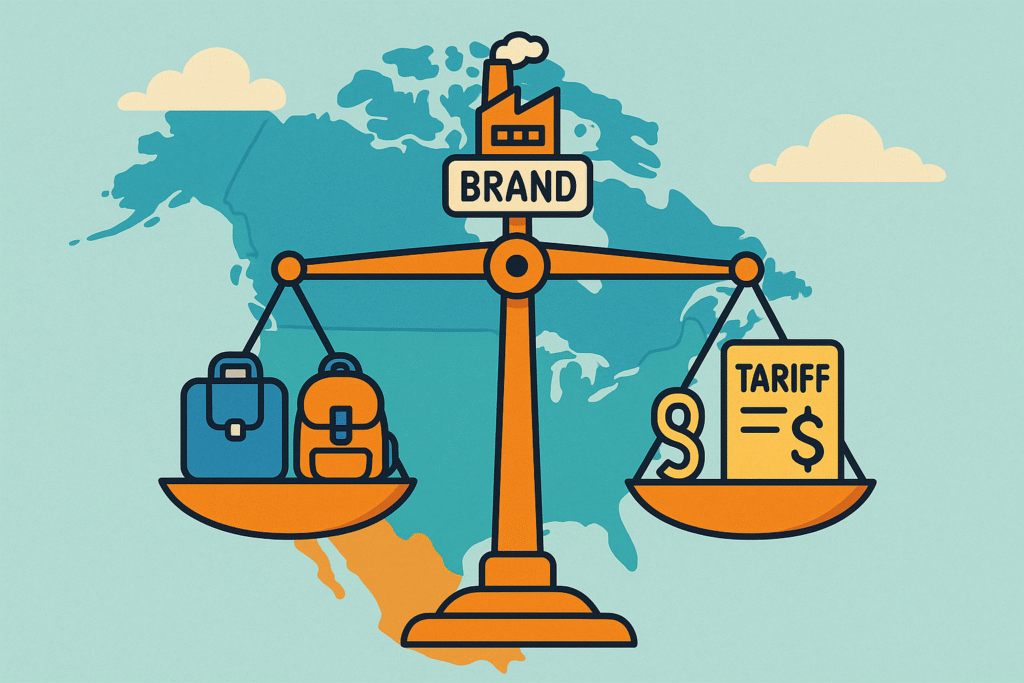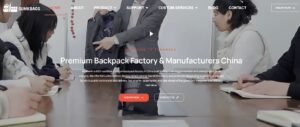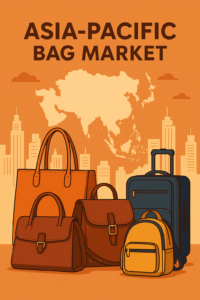Here’s an enhanced analysis—from the perspectives of bag manufacturers and brands—for major North American market trends in travel bags and backpacks, with tailored recommendations. The analysis integrates Travel Bag & Backpack market data, consumer preferences, and tariff impact as of mid‑July 2025.
📊 Market Overview
Travel Bags (North America & U.S.)
- North America travel‑bag market was valued at around USD 8.18 billion in 2024, with a projected CAGR of 6.3 % out to 2030, reaching approximately USD 11.79 billion.
- For women’s travel bags specifically, U.S. market size was about USD 1.5 billion in 2024, forecast to grow at 6.8 % CAGR to potentially USD 2.8 billion by 2033.
Backpacks (U.S. & North America)
- The U.S. backpack market: USD 5.13 billion in 2023, projected to reach USD 6.68 billion by 2031 (CAGR 3.4 %).
- Global backpack market: from USD 20.56 billion in 2024 to around USD 27.85 billion by 2029 (CAGR 6.4 %); North America alone held 35.16 % of global share in 2024 and U.S. market may reach ~USD 10.25 billion by 2032.

🧭 Trends & Manufacturer Implications
Consumer Preferences & Segment Drivers
- Travel bags benefit from rising tourism, solo leisure travel, especially among women—demanding combinations of style, function, and compliance with airline regulations.
- Backpacks are driven by outdoor recreation, digital‑nomad lifestyles, back‑to‑school demand, and interest in tech‑enhanced features (charging ports, security, health tracking).
- Luxury and premium segments in handbags/backpacks lean heavily toward leather and vegan‑leather with younger consumers charting growth in sustainable purchases.
Tariff Impact & Supply Chain Considerations
- New U.S. tariff regime (applied from early 2025) includes universal 10 % baseline, up to 145 % on Chinese imports, 20–25 % for EU goods, and selective country exemptions (Canada/Mexico) under USMCA.
- Small backpack and travel‑gear manufacturers (especially domestic “cottage” producers) face cost pressures or exit, while large global brands remain more resilient Backpacking Light.
- Luxury handbags from Europe face 20 % tariffs on EU imports, leading to price hikes of similar magnitude Market.us News.
- Brands like Coach (via parent Tapestry) have limited tariff exposure because of diversified sourcing in Vietnam, Cambodia, Philippines—not overly reliant on China—and strong full‑price sales in North America; they’ve raised forecasts on this basis.
- Some brands are shifting production to the U.S. to avoid tariffs—“Made in America” is increasingly viable even for premium brands like Louis Vuitton.
🧩 Recommendations for bag Brands & Manufacturers
1. Diversify Sourcing & Manufacturing Strategy
- Reduce reliance on high‑tariff regions—shift production to USMCA‑compliant sources (Mexico/Canada) or Southeast Asia (Vietnam, Cambodia, Philippines) to avoid steep Chinese or EU duties.。
- Consider onshore assembly or full production in the U.S., especially for mid‑tier and premium products, both to cut import taxes and to enhance appeal under “Made in USA” branding.
2. Optimize Product Mix & SKU Portfolio
- Luxury consumers remain willing to pay premium, but price elasticity is increasing—as shown by Levi Strauss and others limiting SKUs to optimize inventory and avoid markdowns under tariff‑induced cost pressure Reuters.。
- Focus on core, high‐margin styles—for travel bags: leather or vegan‑leather, clean designs; for backpacks: tech‑enabled features and durable materials.
3. Channel Strategy: Accelerate E‑Commerce & Omnichannel
- Online channels currently dominate sales—~50 % for travel bags and backpacks—providing better margin control amid rising import costs.。
- Strengthen D2C and omnichannel presence to control pricing, avoid markdowns, and offer personalization.
4. Segment Positioning & Consumer Targeting
- Women’s travel‑bag segment offers strong growth; brands should tailor design, aesthetic, functionality to this demographic’s needs (e.g. trolley-compatibility, compartments, style).
- For backpacks, focus on active/outdoor and tech-savvy customers—products with USB charging ports, anti‑theft zippers, ergonomic straps and sustainability messaging.
5. Tariff‑Driven Pricing and Communication Strategy
- For brands sourcing from high‑tariff origins, consider selective price adjustments, as many are doing rather than blanket increases, to preserve consumer goodwill.
- Clear communication of quality, ethical sourcing, and any local‑production credentials can justify limited price increases.
6. Monitor Trade Policy & Respond Flexibly
- Tariff policy is still fluid—new duties scheduled for August 2025 and beyond may shift; brand supply-chain planning must remain agile.
- Companies should stress-test cost scenarios and prepare rapid supplier shifts if new trade agreements or tariffs emerge.
🧠 Summary Table
| Category | Travel Bags | Backpacks |
|---|---|---|
| Market Size CAGR | ~6.3 % (2024–2030) | ~6.4 % globally, ~3.4 % U.S. (2024–31) |
| Consumer IDs | Female solo travelers, fashion-aware | Outdoor, digital nomads, students |
| Materials | Leather, vegan-leather | Polyester, nylon, leather (premium) |
| Channels | Online (~50 %), retail | Online (~55 %), retail |
| Tariff Exposure | High on EU imports, China minimal if diversified | High for SMEs; large brands buffer via global sourcing |
| Brand Strategy | Focus premium women’s lines, local assembly to avoid tariffs | Tech-enabled, durable, outdoor styling; streamline SKUs |
✅ Actionable Takeaways for bag Manufacturers & Brands
- Rebalance production away from high‑tariff jurisdictions; U.S. and USMCA sourcing offer strategic advantage.
- Consolidate product lines toward best-selling SKUs to reduce cost and complexity.
- Leverage e‑commerce and brand storytelling (e.g. sustainability, made-in-USA, smart features) to preserve margins.
- Target high-growth segments (women’s travel bags, tech-rich backpacks, eco-conscious premium buyers).
- Build agility into sourcing and pricing strategy to respond to evolving trade policies and tariff schedules.
The landscape remains dynamic—especially around tariffs and shifting policies—but large, well‑capitalized brands with flexible sourcing and strong consumer insight are best positioned to thrive in this evolving North American market.




